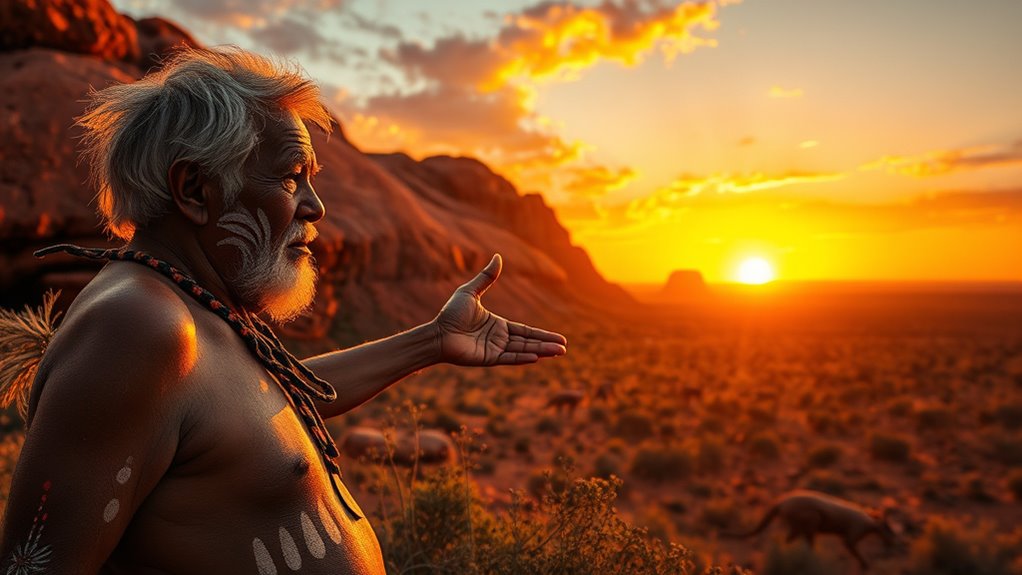Indigenous Australian names are steeped in meaning, connecting you to Dreamtime stories that narrate creation and ancestral ties. These names aren’t just labels; they embody history and spirituality, reflecting the rich cultural beliefs of the land. When you explore these names, you uncover the narratives linked to sacred sites and the dreams of people past. With every name you discover, a deeper cultural significance awaits you, revealing more about this vibrant heritage.
Key Takeaways
- Indigenous Australian names embody history and spirituality, connecting individuals to ancestral stories and the land.
- Each sacred site has unique names that reflect Dreamtime characters and cultural significance, revealing deep-rooted beliefs.
- Aboriginal art serves as a visual representation of Dreamtime stories, encoding layers of meaning through symbols and patterns.
- Understanding the significance of names fosters respect for Indigenous traditions and enhances appreciation of their cultural heritage.
- Names of places and people preserve cultural identity, linking communities to their ancestral narratives and ongoing cultural legacy.

Have you ever wondered how the names of places and people in Indigenous Australian culture carry profound meanings linked to their Dreamtime stories? These names are more than just labels; they embody the rich fabric of history, spirituality, and connection to the land. When you explore the significance of these names, you uncover a world where every syllable resonates with stories handed down through generations.
Take, for example, the names of sacred sites. Each location has its own story, often associated with the creation of the world and the ancestral beings who shaped it. When you visit a sacred site, you’re not just stepping onto a piece of land; you’re entering a narrative that’s deeply rooted in the culture of the Aboriginal people. You might find a specific rock formation named after a Dreamtime character, and by understanding that name, you gain insight into the beliefs and traditions of the people who’ve traveled that land for thousands of years.
Each sacred site tells a story, connecting us to the ancestral beings and rich traditions of Aboriginal culture.
Aboriginal art often reflects these same stories, serving as a visual depiction of the Dreamtime narratives. When you look at a piece of Aboriginal art, you’re seeing more than colors and patterns; you’re witnessing stories of creation, survival, and the ongoing bond to the land. Each brushstroke or carving is purposeful, carrying layers of meaning that connect the artist to their ancestors and their heritage. As you admire the artwork, consider how the names of the places and people depicted relate back to the sacred stories told for generations.
It’s fascinating to think about how language and culture interweave in this context. The names and their meanings shape the identity of the community, reinforcing their bond to the land and its stories. When you learn these names, you’re not just acquiring knowledge; you’re participating in a living tradition, honoring the ancestral wisdom that continues to guide Indigenous Australians today. Understanding these names can also enhance your appreciation for the cultural heritage that informs their history and identity.
In your journey to understand these names, you’ll discover that every place and person holds a story waiting to be told. By appreciating the depth and significance of these names, you’ll gain a greater appreciation for the rich cultural heritage of Indigenous Australians. So, next time you hear an Indigenous name, take a moment to reflect on the Dreamtime stories behind it; you might just find a new world unfolding before your eyes.
Frequently Asked Questions
How Can I Learn More About Indigenous Australian Languages?
To learn more about Indigenous Australian languages, start by exploring ethnolinguistic research, which investigate into these languages’ unique structures and cultural significance. You can find resources online, such as academic papers and language revitalization programs, that offer valuable insights. Joining community workshops or language classes can also deepen your understanding and connection. Engaging with Indigenous communities directly will enrich your learning experience and help support their language revitalization efforts.
Are There Specific Cultural Practices Associated With Naming Ceremonies?
Yes, there are specific cultural practices associated with naming ceremonies. During naming rituals, families often gather to celebrate the new life and choose a name that reflects cultural significance. These cultural ceremonies can include storytelling, singing, and dancing, highlighting the community’s connection to the child. You’ll find that each community has its unique traditions, emphasizing the importance of heritage and identity, making these events deeply meaningful for everyone involved.
What Is the Significance of Totems in Indigenous Culture?
Totems hold deep significance in Indigenous culture, representing spiritual connections and ancestral identity. They’re often linked to a person’s clan, guiding their responsibilities and relationships within the community. When you embrace your totem, you acknowledge a bond with nature and your ancestors, fostering a sense of belonging. This connection helps you navigate life, reminding you of your heritage and the values that shape your identity. It’s a powerful reflection of who you are.
How Do Indigenous Australians Preserve Their Oral Traditions Today?
Indigenous Australians preserve their oral traditions today through vibrant storytelling techniques during community gatherings. You’ll find elders sharing stories that connect the past with the present, using engaging methods like song, dance, and visual art. These gatherings foster a sense of belonging and cultural pride, ensuring that younger generations absorb the rich narratives. By actively participating, you help keep these traditions alive, bridging the gap between ancient wisdom and modern life.
Can Non-Indigenous People Use Indigenous Names Respectfully?
Yes, non-Indigenous people can use Indigenous names respectfully, but it’s essential to approach it with cultural sensitivity. You should engage with Indigenous communities and seek permission to guarantee you’re honoring their heritage rather than appropriating it. By fostering respectful engagement and understanding the significance behind the names, you can avoid cultural appropriation. Always prioritize listening to Indigenous voices and acknowledging their history and traditions in your usage of their names.
Conclusion
In exploring Indigenous Australian names and Dreamtime stories, you discover a rich tapestry of culture and history that spans over 65,000 years. This deep connection to the land and its stories is not just fascinating; it reveals the importance of preserving these narratives for future generations. Did you know that over 250 Indigenous languages are still spoken today? Each language carries unique stories and meanings, highlighting the crucial role of cultural heritage in shaping our understanding of the world.









